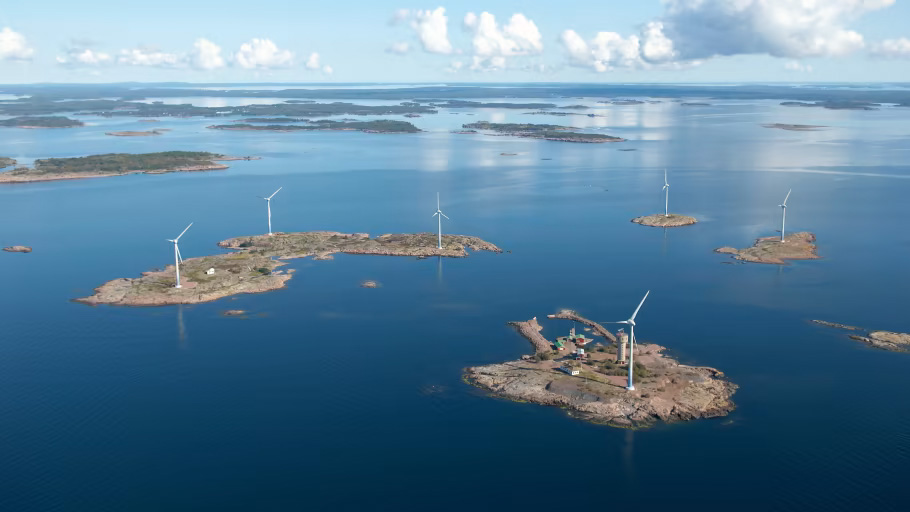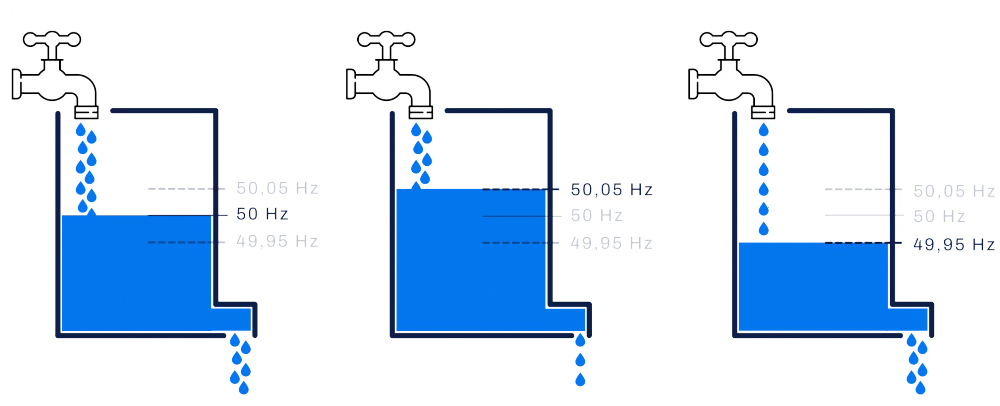Frequency regulation in a nutshell, and how Pumped Hydro Storage can facilitate the shift to renewable energy sources
4 march 2022
 The old iron mine at Åland (Finland) could become an asset for future grid stabilization through the construction of a pumped storage hydropower facility.
The old iron mine at Åland (Finland) could become an asset for future grid stabilization through the construction of a pumped storage hydropower facility.
Frequency regulation, peak shifting, demand response, voltage control. The power system is an extremely complex organism that needs precise control to function properly. In this article, we will describe how the already complicated grid management will become even more complex as we go towards a more sustainable energy supply.
– As we become more dependent on intermittent energy sources like wind and solar power, we must find new ways to balance the production from these unplannable sources of production in order enable a secure and stable energy supply. Both on a minute to minute basis, as well as over several hours, says Mikael Bergmark, Project Manager, SENS.
Let us start with a basic but fundamental piece of information – every time we use electricity in our daily lives, this electricity must be produced somewhere else in the power system, at the exact same time. This means that if you plug in your car charger, the power production in the grid must increase with the amount of power that your charger uses. When you plug it out, the production must decrease again. As the consumption in the grid is quite predictable and depends on weather conditions, factory hours etcetera, the large production loads are planned and purchased beforehand. However, as the consumers are free to use the power whenever they want, there will always be a deviation from this value and continuous change in consumption.
– You can think of it as a water container with a faucet and a drain; if the flow of the faucet is bigger than the flow of the drain water level will rise. If the inflow instead is too small, the water level will decrease. Small deviations are expected and won’t cause issues, since this can be corrected over time. But if the discrepancy between the water flow and drain is too large, the risk is that the water overflows, Mikael Bergmark says.
Balancing the grid
In the grids, the water level is represented by the frequency. All power grids have alternating current (AC), which means that the current changes direction continuously with a specific frequency (Hz). In Europe and most of the world, the frequency is 50 Hz. If the power production is higher than the consumption, the frequency will increase above 50 Hz and vice versa. The system operators, who are responsible for the stability of the grid, will beforehand purchase available capacity from different sources. These resources will then increase or decrease production or consumption in real-time to maintain grid stability.
– However, if the discrepancy between production and consumption is too large and the frequency is too low, sensitive equipment in large production units risk large damages and they therefore have the right to disconnect from the grid. This means that the production is decreased further, and an even larger discrepancy between supply and demand, risking a cascade of more disconnection of production sources, Mikael Bergmark says.
 The power frequency can be seen like water flowing in and out of a container. If the inflow is larger than the outflow, the water level will increase. Similarly, if the power generation is larger than the consumption, the frequency in the grid. The opposite goes for if the outflow is larger than the inflow. In order to maintain balance in the container, or the grid, the inflow must be equal to the outflow.
The power frequency can be seen like water flowing in and out of a container. If the inflow is larger than the outflow, the water level will increase. Similarly, if the power generation is larger than the consumption, the frequency in the grid. The opposite goes for if the outflow is larger than the inflow. In order to maintain balance in the container, or the grid, the inflow must be equal to the outflow.
The shift to renewable energy requires storage solutions
When producing power from fossil sources, nuclear and hydropower you can decide when and how much electricity you want to produce. These are so-called dispatchable sources of power. But if we are to achieve a sustainable power system and reach our climate targets, we need to eliminate our need for fossil fuels and replace them with non-fossil sources, such as renewable production like solar and wind power. These are intermittent sources, which means that their times of available production is not steerable but decided by current weather conditions.
– This means that even if we are very good at predicting the weather, and therefore quite accurately can predict the production from these intermittent sources, the wind speeds can be lower or higher than predicted. Also, the output from a solar power park can change quickly if, for instance, an unexpected cloud covers the sun. With our solution of storing energy in disused mines through pumped hydro storage, we can both balance these sudden changes due to our quick start-up times, but also store intermittent energy when the production is high and then supply energy for many hours if needed, Mikael says.
Using height differences to store energy
Hydropower has long been used both as a plannable production resource as well as for frequency regulation. The pumps and turbines that will be used in the pumped hydropower storage facilities developed by SENS can be constructed to easily and with high efficiency operate on different outputs, enabling a sustainable and efficient resource for frequency regulation. This will be done in addition to its ability to efficiently store large amounts of energy. All of this by reusing existing mines and infrastructure, with the mature technology of pumps and turbines.
– In 2040, it is predicted that 10 per cent of the electricity produced at some time will be stored in a long-duration energy storage facility. The demand for storage in a world with an ever-increasing electrification. Our solution is very flexible and can be deployed in places where conventional pumped storage cannot, by making use of a left-over from the industry; mining assets and their infrastructure, Mikael Bergmark concludes.